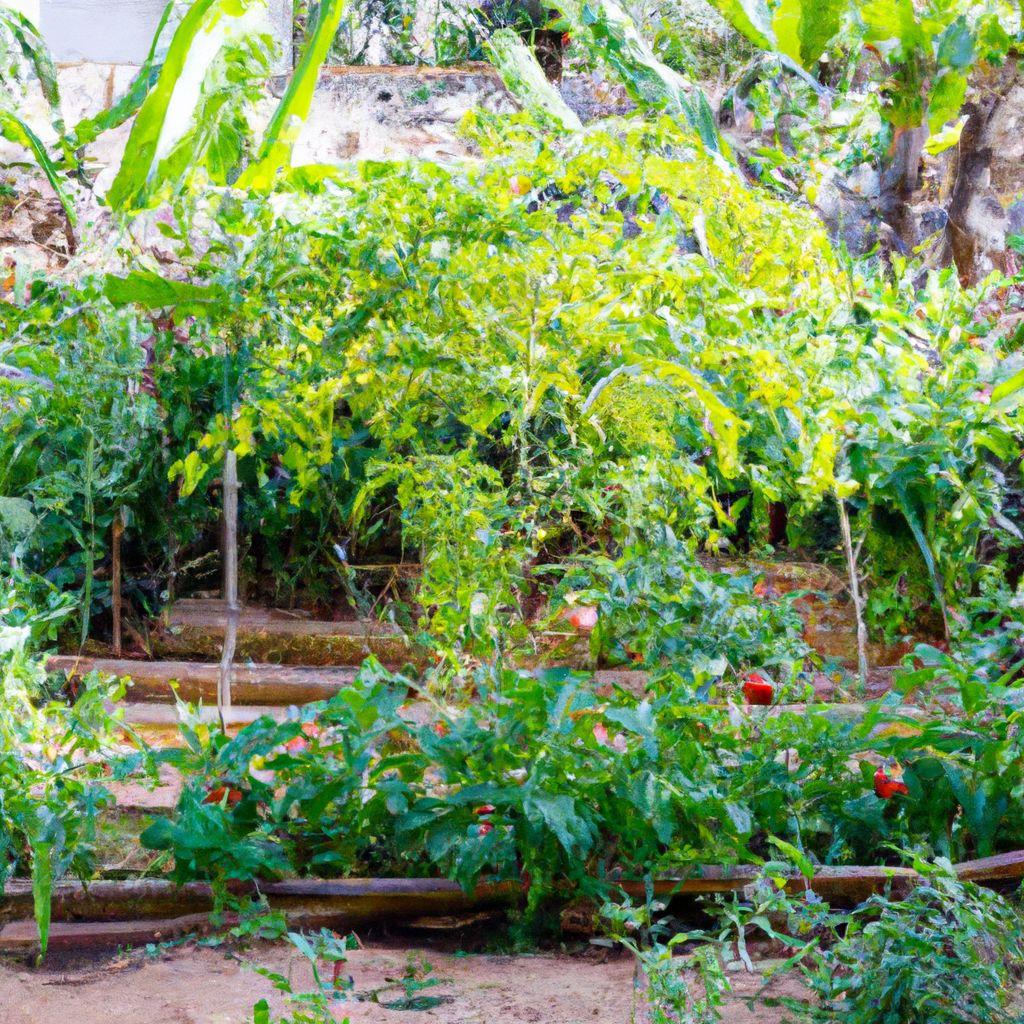Key Takeaway:
- Understanding the differences between tropical and sub-tropical climates is crucial for successful organic vegetable gardening in tropical climates.
- Preparing the right site, removing weeds and grasses, and choosing a gently sloping site with good drainage are important steps in creating an optimal environment for organic vegetable gardening.
- Implementing the no-dig gardening method, adapting it to warm climates, and using suitable mulching options will help retain moisture, suppress weeds, and improve soil fertility in tropical gardens.
Introduction
Understanding the differences between tropical and sub-tropical climates is crucial when it comes to organic vegetable gardening in such regions. In this introduction, we will provide a brief overview of the unique challenges and considerations that come with organic vegetable gardening in tropical climates. We will also explore the importance of understanding these climate distinctions and how they can impact the success of your gardening endeavors.
Importance of Understanding the Differences Between Tropical and Subtropical Climates
Organic vegetable gardening requires a good understanding of the differences between tropical and subtropical climates. In tropical climates, it is hot and humid all year round. Whereas in subtropical climates, there are variations in temperature and rainfall. Knowing this helps gardeners decide which vegetables to grow and how to take care of them.
The climate significantly affects how vegetables grow. High temperatures and humidity can change their growth rate and make them more susceptible to pests and diseases. Therefore, selecting vegetables that are suitable for the climate is important.
Gardeners must also consider the different growing seasons of crops. Some prefer cooler months while others like warmer temperatures. Knowing the climate helps gardeners plan their planting schedules for maximum yield.
In conclusion, understanding the different climates is fundamental for successful organic vegetable gardening. It allows gardeners to choose the right vegetables, use the right techniques, and plan their planting schedules. This knowledge leads to abundant harvests of fresh organic vegetables.
Brief Overview of Organic Vegetable Gardening in Tropical Climates
Organic vegetable gardening in tropical climates requires special considerations for success. The warm, humid conditions of the tropics bring both advantages and difficulties. By understanding its special features, gardeners can use techniques and choose suitable plants that flourish in these climates.
Creating good compost is key for optimal growth in tropical climates. This will give the seeds or seedlings the nutrients they need.
Choosing the right site is also important. Removing weeds and grasses helps to create a weed-free environment, so that crops can grow without competition for resources. A gently sloping site with good drainage is ideal for organic vegetables in tropical climates.
The no-dig gardening method is useful in warm climates. Using extra layers of newspaper for mulch suppresses weeds and keeps the soil moist. Blady grass hay can also be used. Avoid straw with wheat seeds, as this may contaminate the garden.
Water the no-dig garden and ensure decomposition takes place properly. Mix compost with soil when planting in designated holes or lines for healthy growth.
Start small and increase the size of the garden gradually. This allows gardeners to gain experience and better manage their crops in tropical climates. It also reduces the initial workload and increases the chances of success.
When selecting vegetables, leafy greens and cool-weather crops require special attention. They are susceptible to heat stress or bolting under high temperatures.
Seed trays are helpful for overcoming challenges with planting calendars in different regions. Timing for different crop seasons is essential in tropical climates.
To deal with pests and diseases, use natural methods and proper care. Consult local resources for climate-specific guidance.
Vegetables tolerant to heat and humidity are best suited for tropical gardens. Guidelines for beans, peas, turmeric, eggplants, and more offer valuable insights.
Tropical climates have two main seasons – hot/rainy season and cool/dry season – which must be managed. Pests, diseases, soil improvement, seed trays, and vegetable bed recommendations must be considered.
Fruit trees and herbs that are suitable for tropical gardens offer a consistent supply of produce throughout the year.
Protective measures like dealing with pests and wearing protective clothing are essential when gardening in the tropics. Recognizing the challenges and rewards is important.
Preparing for Organic Vegetable Gardening
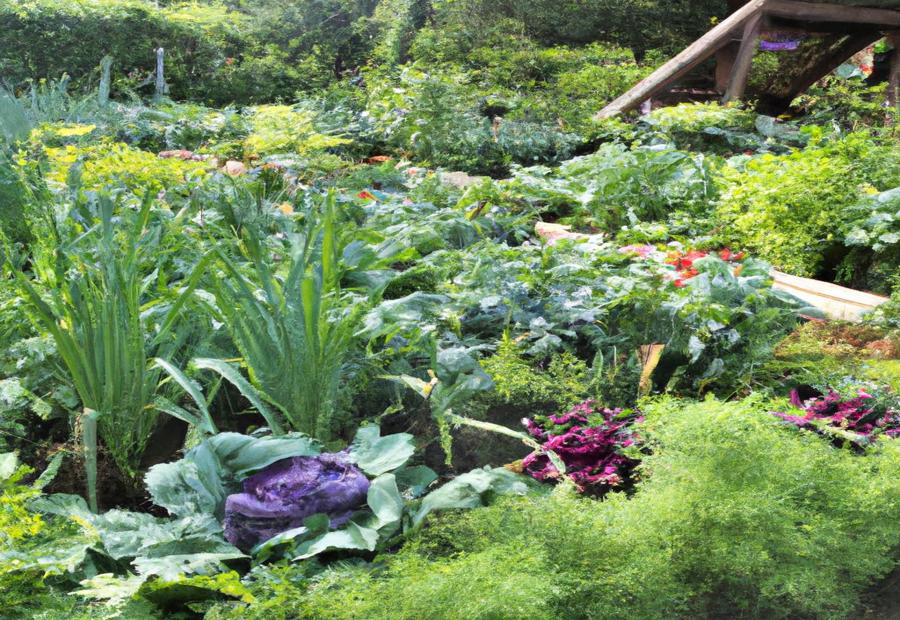
Photo Credits: Gardeninggurus.Org by Lawrence Nguyen
Preparing the groundwork is essential for successful organic vegetable gardening in tropical climates. In this section, we’ll explore the art of creating well-made compost, a crucial step that enriches the soil and provides a nutrient-rich foundation for your garden. Discover how composting not only reduces waste but also enhances plant growth, promotes soil health, and contributes to sustainable gardening practices. Let’s dig in and learn how to create the perfect compost for your organic vegetable garden in tropical climates.
Creating Well-Made Compost
Creating quality compost is major for successful vegetable gardening in tropical climates. Compost supplies vital nutrients, strengthens soil structure, and increases soil moisture. It also motivates helpful microbe activity and decreases the risk of plant diseases and pests.
Follow these five steps to make great compost for seeds or seedlings:
- Utilize a fitting compost bin or pile for good aeration and drainage.
- Gather diverse organic materials like kitchen scraps, yard waste, and dry leaves.
- Layer the materials alternately with soil or finished compost for a balanced carbon-rich (browns) and nitrogen-rich (greens) combination.
- Keep the compost moist by watering it or covering it during rain.
- Turn the compost pile often to aerate and speed up decomposition.
These steps will help create well-made compost for nourishing seedling growth in tropical climates. Consider specific factors like higher temperatures and faster decomposition. Use extra-thick newspaper to retain moisture in warmer areas. Also, choose materials without wheat seeds as it may cause unwanted wheat sprouts in the garden bed. Blady grass hay is suitable for tropical gardens.
By following these recommendations and adjusting composting practices to tropical climates, you can make great compost for your organic vegetable garden. This will promote optimal plant growth and yield. Good compost is the seedling’s best friend, showing that who you know is key, even in the plant world!
Importance of Having Quality Compost for Seeds or Seedlings
Quality compost is key for successful seed and seedling growth. It provides the nutrients and organic matter needed. Improving soil structure and texture, compost helps water retention and boosts microbial activity. It acts as a natural fertilizer, giving essential elements for germination and development.
Using quality compost suppresses weeds and reduces pests. Plus, the soil structure permits better aeration and root penetration, making plants stronger and more resilient.
Not all compost is suitable though; poor-quality or not fully decomposed compost may contain weed seeds, pathogens, or too much salt. To use it in organic vegetable gardening, make sure the compost is of high quality and has been aged and decomposed correctly.
With quality compost, gardeners can give their seeds and seedlings a nutrient-rich environment promoting growth. This means healthier plants with improved disease and pest resistance, great for organic vegetable cultivation in tropical climates.
Find the perfect spot for your garden – weed-free and good drainage like the ideal roommate!
Choosing the Right Site for Your Garden
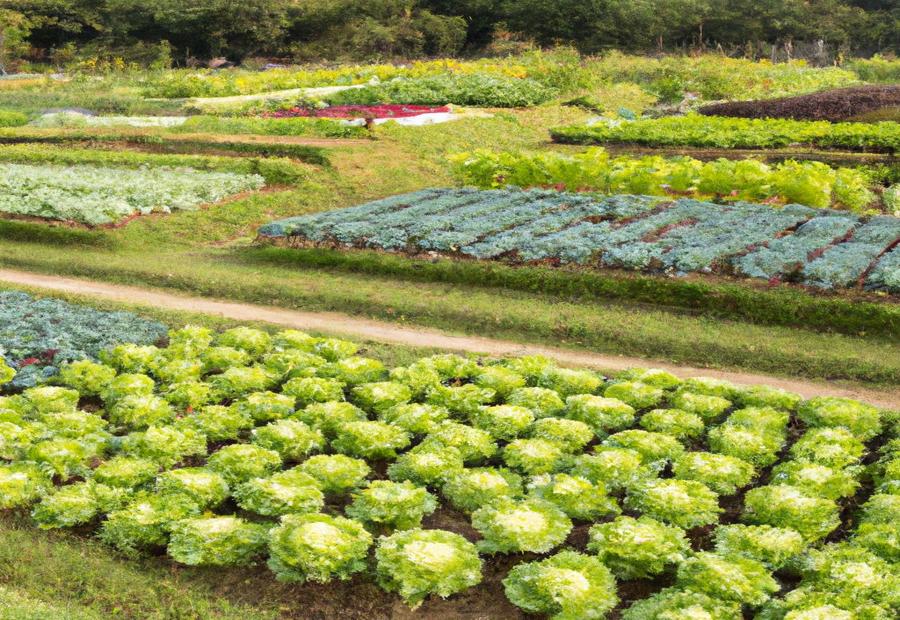
Photo Credits: Gardeninggurus.Org by Aaron Taylor
Choosing the right site for your organic vegetable garden is crucial. We’ll explore how to remove weeds and grasses effectively, and discover the optimal site characteristics for a successful garden. With these insights, you’ll be well-equipped to create a thriving garden in even the most challenging tropical climates.
Removing Weeds and Grasses
To keep a healthy, productive veggie garden in tropical climates, it’s essential to get rid of weeds and grass. They take away nutrients, water, and sunlight from the veggies. By dealing with this issue, gardeners can make an ideal environment for their vegetables to flourish.
Here’s a 4-Step Guide to Removing Weeds and Grasses:
- Identify the undesired plants: Check your garden area often. Look for both visible foliage above ground and underground roots or stems.
- Pull or dig out the plants: Use gardening gloves to gently pull out small weeds from the root. For bigger weed species or clumps of grass, use a hand trowel or digging tool to carefully remove them from the soil.
- Dispose of removed plants properly: Don’t let the pulled weeds and grasses grow in different parts of the garden. Put them in a designated bag or compost pile away from the veggies.
- Mulch to stop weed regrowth: Put a layer of organic mulch around vegetable plants after getting rid of weeds and grasses. This stops new growth by blocking sunlight and stopping weed germination.
Removing weeds and grasses from the garden area means less competition for resources among the veggies. This leads to healthier growth and helps the crops reach their full potential.
Pro Tip: Maintaining the garden is key in stopping weed establishment. Check it regularly for new weed growth so you can quickly address them.
Starting with a weed-free site is the first step to a successful garden – unless you want your plants to compete in the Weed Growing Olympics.
The Significance of Starting with a Weed-Free Site
Beginning with a weed-free site is key for organic veggie gardening in tropical climates. Weeds can battle for nutrients, water, and sunshine with the veggies, retarding their development. Plus, some weeds may contain pests and illnesses that can be bad for the vegetable plants. By starting with a weed-free site, gardeners can make an ideal environment for their veggies to flourish.
One of the reasons why starting with a weed-free site is vital is that it reduces rivalry between weeds and vegetables for essential resources. Weeds can spread quickly and overpower vegetable plants if not checked. They take valuable nutrients from the soil, leaving fewer accessible for the veggies. By removing weeds before planting, gardeners guarantee that their vegetable plants get the most extreme measure of nutrients they need to develop sound and sound.
Additionally, a weed-free site likewise assists with forestalling the spread of pests and illnesses. Weeds can fill in as hosts for bugs and pathogens that can harm vegetable plants. If these weeds are close to the garden, they can without much of a stretch move pests and ailments to the vegetables. By beginning with a weed-free site, gardeners get rid of potential sources of attack and decrease the danger of their harvests being harmed.
Finding the perfect site for your tropical garden is like finding a needle in a haystack, but without the prickly pain.
Optimal Site Characteristics
Let’s explore the reference data about optimal site characteristics for tropical gardening. It stresses a gently sloping site with good drainage. A gentle slope stops waterlogged soil. Good drainage helps keep the right moisture level.
Moreover, a weed-free site is important. Clear weeds and grasses before planting. This provides a healthy foundation for organic vegetable gardening.
These details haven’t been covered before. The reference data focuses on composting, choosing seeds or seedlings and watering practices. Knowing this brings new insight into successful tropical gardening.
It’s recommended to choose a garden site with a gentle slope and good drainage. Natural slopes and draining mechanisms like trenches or raised beds help divert water away from plant roots. Weed control should be maintained to use resources for growing vegetables.
By implementing these optimal site characteristics, tropical gardeners create an environment that promotes healthy growth while minimizing challenges. This contributes to the success and productivity of organic vegetable gardening in tropical climates.
Benefits of a Gently Sloping Site and Good Drainage
A gently sloping site with good drainage offers a host of advantages for organic veggie gardening in the tropics. The slope ensures excess water drains away, preventing waterlogged soil which can cause root rot and other diseases. Plus, it allows for better air circulation and minimizes soil erosion. Plus, it allows nutrients from compost and organic matter to absorb into plant roots more easily, improving growth. It also prevents the build-up of standing water, reducing the risk of fungal and bacterial illnesses.
The slope also helps with irrigation management – water can flow evenly throughout the garden, decreasing wastage. This is key to successful organic veggie gardening in the tropics!
We have a true story that proves this point. A gardener moved their garden to a gently sloping area and saw huge improvements in their veggies. Disease incidence decreased and nutrient availability improved. It’s a great reminder of the importance of selecting a site with good drainage.
Implementing the No-Dig Gardening Method
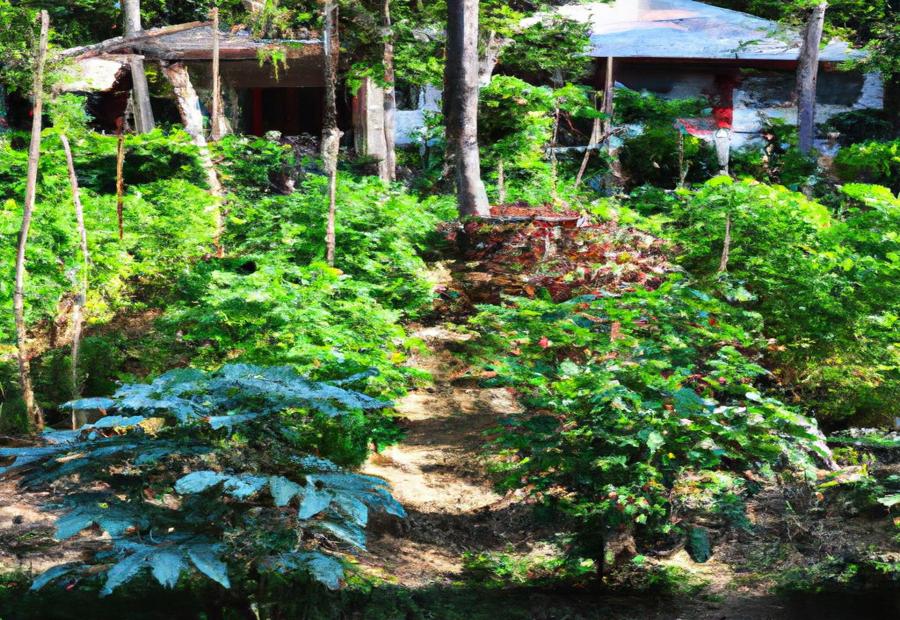
Photo Credits: Gardeninggurus.Org by Michael Hall
Implementing the no-dig gardening method in tropical climates: adapting it to warm climates and exploring mulching options for tropical gardens.
Adapting the Method to Warm Climates
To adapt gardening methods to warm climates, adjustments must be made. Unique challenges exist that require strategies for optimal plant growth and productivity.
- Choose heat-tolerant crops. Vegetables that can survive high temperatures without reducing growth and yield are best.
- Provide shade. Use shade cloth, trellises, or structures to protect plants from excessive heat and sun.
- Ensure proper irrigation. Water evaporation is a risk, so use drip irrigation and mulch to retain soil moisture.
- Implement regular monitoring. Keep track of soil moisture, nutrients, and pest infestations.
- Adjust planting schedule. Plant during cooler times and choose crops that thrive in warmer temperatures.
Other challenges in warm climates like high humidity and disease pressure can be overcome with these steps. For extra mulching material, try newspaper. Wheat straw should be avoided due to contamination, but blady grass hay is a suitable alternative with weed suppression capabilities.
By following these strategies, gardeners can create a thriving garden in tropical and subtropical conditions.
Using Extra Thicknesses of Newspaper in Warmer Climates
Organic vegetable gardening in tropical climates can benefit from extra layers of newspaper. Research shows this method can be adapted to warmer climates.
The no-dig gardening technique using newspaper suppresses weeds and grasses. In warmer climates, extra thicknesses are beneficial for better weed control. Sunlight is blocked, preventing germination.
Plus, the extra layers help retain moisture in the soil. This is especially important in tropical climates with high temperatures and evaporation rates.
Using newspaper as mulch also helps regulate soil temperature. In warm climates, protecting plant roots is key.
Thicker layers of newspaper can improve organic matter decomposition. This increases soil fertility and structure by speeding up nutrient release.
Mulching Options for Tropical Gardens
Blady Grass Hay is a must in tropical gardens. It helps keep moisture in the soil, stops weeds from growing, regulates soil temperature and even improves soil fertility. It’s not the only option though – newspaper can also be used, as long as it’s not treated with chemicals. Straw with wheat seeds should be avoided, as it can compete with vegetable plants.
When mulching, thickness and timing are important. Select the right materials and apply them correctly for optimal growing conditions. This will ensure your organic vegetables thrive in a tropical climate.
Make sure you get the most out of mulching by using Blady Grass Hay and extra layers of newspaper. Avoid straw with wheat seeds and you’ll be in good shape! With the right techniques, you can take full advantage of your tropical gardening efforts.
Blady Grass Hay as a Suitable Mulch Option
Blady Grass Hay is perfect for tropical gardens. It has many advantages: suppressing weeds, keeping soil moist, regulating temperature, and improving soil health and fertility. The article also suggests layering newspaper under the hay to protect against intense heat. By combining these techniques with mulching using Blady Grass Hay, gardeners can create a great growing environment for their organic vegetables.
It is important to take caution when choosing other types of straw. Some may contain wheat seeds that could compete with veggies for nutrients and space. So it’s best to avoid straw with wheat.
Gardeners should harvest the grass before it goes to seed. They should also lay a thick layer of hay over wet newspapers or directly on the prepared soil bed. This will maximize the benefits of Blady Grass Hay and create an ideal growing environment, reducing weed growth and conserving moisture levels.
To sum up, Blady Grass Hay is an excellent mulch option for tropical gardens. With the right installation techniques, gardeners can ensure their organic vegetables thrive.
Caution Against Using Straw with Wheat Seeds
Caution is advised when planting wheat seeds. Straw should not be used as a mulch option. It may impede wheat’s growth and development. Though, straw can be great for other plants. It’s not a good idea to use it with wheat due to issues in germination and establishment.
Straw can have negative effects on wheat’s growth. It can create a barrier which prevents seedlings from breaking through the soil. This blocks sunlight, essential for photosynthesis and early development.
Pests or pathogens may hide in the straw. This can lead to increased damage and disease.
It’s best to explore alternative mulching options for wheat. This reduces potential barriers or risks associated with unsuitable mulch materials.
Planting and Growing Organic Vegetables
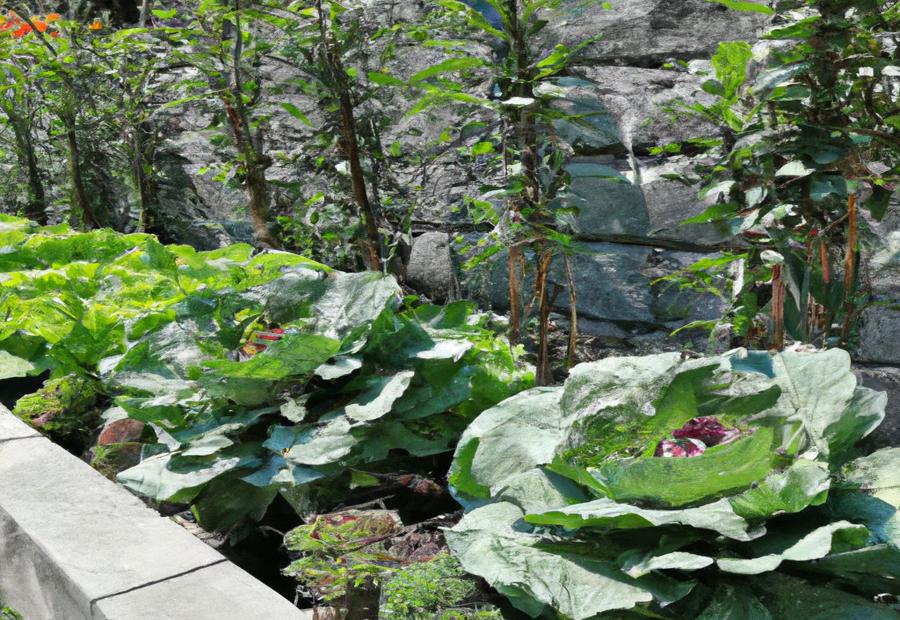
Photo Credits: Gardeninggurus.Org by Henry Rodriguez
When it comes to planting and growing organic vegetables in tropical climates, there are important steps to consider. We’ll dive into preparing a no-dig garden, the importance of mixing compost with soil, and the benefits of starting small and expanding your garden. Get ready to unleash your green thumb and enjoy the bounties of organic vegetable gardening in the tropics!
Preparing the No-Dig Garden
Preparing a no-dig garden in tropical climates is a key part of organic vegetable gardening. Here’s a 6-step guide for success:
- Put down a thick layer of newspaper or cardboard. This stops weeds and holds moisture.
- Add a generous amount of high-quality compost. This provides nutrients and improves soil structure.
- Cover with organic mulch like straw or blady grass hay. This retains moisture, regulates soil temperature and stops weed growth.
- Plant seeds or seedlings directly into the mulch. Make sure to space them properly.
- Water garden thoroughly. Mulch layer helps retain moisture.
- Monitor plants’ progress and periodically replenish compost and mulch.
These steps give you an overview of no-dig gardening. There are still other details to consider.
Proper Watering and Decomposition Process
Ensuring successful organic vegetable gardening in tropical climates requires proper watering and decomposition. Here’s a 5-Step Guide to help!
- Check soil moisture levels with your finger or a moisture meter. The top inch of soil should feel slightly damp, not soaked.
- Give plants a deep soak rather than sprinkling. This encourages root growth. Water should penetrate 6 inches into the ground.
- Don’t overwater; water only when necessary. Allow the top layer to dry out between waterings.
- Mulch to keep moisture in. Use compost or straw. This suppresses weed growth & regulates soil temperature.
- Incorporate well-made compost regularly to promote healthy decomposition. Compost adds nutrients & supports beneficial microbial activity.
To save even more water, use drip irrigation systems or soaker hoses. Rainwater can also be collected in barrels or tanks for later use. Monitor rainfall patterns to adjust watering frequency and avoid hand-watering during rainy seasons.
Compost in soil is like magic, transforming ordinary dirt into nutrient-rich gold!
Mixing Compost with Soil
Mixing compost with soil is key in organic veggie gardening. It gives plants the nutrients they need and keeps the soil healthy. You combine organic matter like decomposed plant material and animal manure with existing soil for a nutrient-rich mix. To do this right, follow these steps:
- Prep the compost. Use a mix of green and brown materials, like kitchen scraps, garden waste, leaves, and straw. Turn it often and make sure it’s fully decomposed.
- Till the soil. Loosen it up to 8-12 inches deep. Take out any weeds or grasses.
- Add compost. Spread a 2-4 inch layer on the tilled soil. Rake or till it into the top inches.
- Mix evenly. Use a garden fork or hoe to blend the organic matter with the soil. Avoid clumps.
Now your soil is ready for healthy veggie growth! In Balinese agriculture, they use fresh manure and water. This is an example of soil enrichment in tropical climates.
Using Compost to Plant in Designated Holes or Lines
Compost planted in designated holes or lines is an effective technique for organic vegetable gardening. It delivers nutrients directly to plants, promoting healthy growth and nutrient uptake. Compost also improves soil structure and water retention, creating the perfect conditions for plant growth.
Here’s a 6-step guide to using compost in designated holes or lines:
- Prepare soil. Remove any weeds or grasses.
- Dig individual holes or create lines.
- Fill holes with generous amount of compost, making sure it reaches base. Spread compost along lines.
- Mix compost with surrounding soil in each hole or along lines. Distributes nutrients and ensures roots have access.
- Plant seeds or seedlings. Follow seed packet instructions for proper spacing and depth.
- Water thoroughly. This settles the soil and helps roots access compost.
Using compost in designated holes or lines maximizes plant health and minimizes nutrient waste and weed competition. Providing needed nutrients directly can result in robust growth and high-quality yields.
So, compost planted in designated holes or lines is beneficial for organic vegetable gardening in tropical climates. Following these steps will ensure that plants receive necessary nutrients for healthy growth and high-quality yields.
A crazy fact: Compost usage can make soil so fertile you’ll be able to grow your own money tree!
Starting Small and Expanding the Garden
Starting small is key! Strategize and think carefully about the available space. Gradually increase the size of the garden to ensure manageability and success.
- Choose a small area with lots of sunlight and easy water access.
- Create designated planting areas using raised beds or containers.
- Start with easy-to-grow veggies that do well in your climate, like beans, peas, and turmeric.
- Keep an eye on growth and progress, and make adjustments as needed.
- Grow your garden slowly by adding more planting areas or utilizing more space.
- Diversify your veggie selection with heat and humidity-tolerant varieties.
Starting small helps focus attention and learn valuable gardening skills. As you gain experience, expand the garden to experiment with different veggies and techniques.
By starting small and gradually increasing the size of the garden, each section can get the proper attention and care it needs. This also allows for better adaptation to local conditions, avoiding over-maintenance.
Benefits of Starting with a Small Area and Gradually Increasing
Beginning with a small garden gives many advantages for organic vegetable gardening in tropical climates. It’s easier to manage and control soil, water, and garden conditions.
- Smaller areas need less attention.
- Also use less compost, mulch, and water.
- Beginners can learn and gain experience.
Benefits:
- Better Management: Easier to look after soil, moisture, etc.
- Resource Efficiency: Less compost, mulch, water.
- Gain Experience: Learn veg requirements for tropics.
It’s important to note that each veg needs different growth needs in tropics. Experiment with small area first to see how they react before larger-scale growing.
Recommended Vegetables for Tropical Gardening
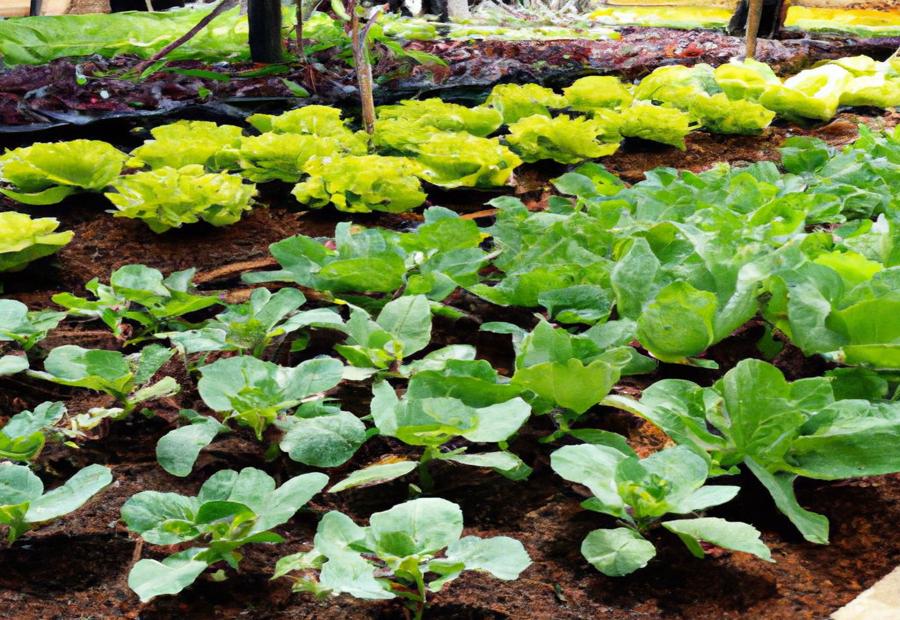
Photo Credits: Gardeninggurus.Org by Donald Taylor
When it comes to organic vegetable gardening in tropical climates, it’s important to choose the right vegetables for your garden. In this section, we will explore the recommended vegetables specifically for tropical gardening. From suitable vegetables for sub-tropical and tropical climates to notes on leafy greens and cool-weather crops, discover the key factors to consider when selecting the perfect vegetables for your tropical garden.
Suitable Vegetables for Subtropical and Tropical Climates
Tropical and subtropical climates bring special challenges and advantages for vegetable gardens. It’s essential to know which vegetables will do well here. Warm temps and humidity can harm plants, but there are lots of veg varieties that love these conditions. For a flourishing garden, consider the following:
| Vegetable | Description |
|---|---|
| Tomatoes | Cherry tomatoes do well in tropics. Sun and water needed. |
| Eggplants | Choose Asian or long types. Warmer temp + good drainage needed. |
| Okra | Heat-loving veg. Lots of sun and watering. |
| Sweet potatoes | Resilient veg that tolerate warmth and humidity. Loose soil and good drainage. |
| Beans | Yardlong and snake beans work well. Support needed for tall growth. |
In addition to the above, think spinach, amaranth, carrots, radishes, basil and lemongrass. Local microclimates and seasonal changes affect growth. Check local resources for best choices.
List of Popular Choices
Tropical climates host a plentiful and diverse range of vegetable garden options! These veggies thrive in the warm temperatures and high humidity, making them perfect for tropical gardening. Popular choices include tomatoes, eggplants, okra, bell peppers, cucumbers, and beans. They offer a whole bunch of flavors, textures, and culinary uses, and can be easily incorporated into many dishes.
Not to be forgotten, other vegetables that can grow in tropical climates are squash, leafy greens, herbs, root vegetables, peppers, and cabbage family. Experiment with different varieties and climates to create a varied vegetable garden that flourishes in the tropics! Don’t forget – cool-weather crops like leafy greens need to be kept out of the cold.
Notes on Leafy Greens and Cool-Weather Crops
Leafy greens and cool-weather crops are a must for organic veggie gardening in tropical climates. These veggies need special care, as they like cooler temps and have unique growth patterns. It’s essential to understand the nuances of growing these veggies for a successful harvest.
Here are some tips for leafy greens and cool-weather crops:
- Lettuce: Plant in shady, well-drained soil.
- Spinach: Sow seeds when it’s cool.
- Kale: Keep moist and protect from heat.
- Swiss Chard: Harvest outer leaves often.
- Broccoli: Start seeds indoors and transplant when temps are mild.
As you can see, these plants have specific needs. Lettuce loves shady, well-drained soil while spinach needs cool temps for sowing. Kale needs moisture and heat protection, while Swiss chard needs regular harvesting of outer leaves. Broccoli should be started indoors and transplanted when temperatures are mild.
By understanding these requirements, gardeners can grow these nutritious veggies successfully in tropical climates.
Planting Tips and Techniques
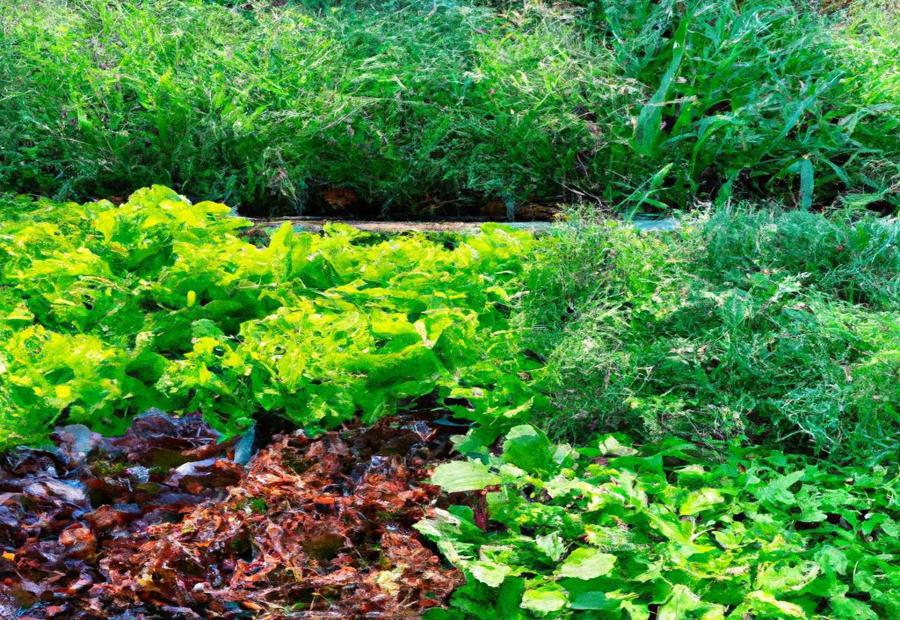
Photo Credits: Gardeninggurus.Org by Willie Lopez
When it comes to planting organic vegetables in tropical climates, mastering the right tips and techniques is essential. In this section, we’ll explore two key aspects: starting seeds in trays and understanding the timing for different crop seasons. Discover valuable insights that will help you maximize your yield in the unique conditions of a tropical climate.
Starting Seeds in Trays
Trays are a great aid for starting veggies organically. They give a controlled environment for germination and early growth, helping gardeners to get an earlier start. Utilizing trays can raise the success rate of seedlings and offer a healthy beginning before transplanting.
A 3-Step Guide to Starting Seeds in Trays:
- Prepare the tray: Fill with a high-quality seed-starting mix and tamp down the soil for even distribution.
- Planting seeds: Place seeds following the recommended planting depth for each type. Put them evenly spaced in rows or individual cells in the tray, not overcrowding.
- Water and care: Water thoroughly after planting. Cover the tray with a humidity dome or cover to make a stable microclimate and retain moisture. Keep the tray in a warm spot with indirect light until germination happens, and slowly add more light as seedlings grow.
Unique Details:
It is important to regulate and adjust the water properly during this critical stage. Overwatering can cause fungal diseases or damping-off, while underwatering can stunt growth or even kill seedlings. Making these water adjustments will support healthy development.
True History:
Starting seeds in trays has been done by gardeners for many years as an effective way to raise germination rates and create healthy seedlings. This technique has its roots in ancient civilizations that saw the advantages of giving the best conditions for plant propagation prior to transplanting into outdoor gardens. Over the years, advancements in horticultural knowledge and technology have perfected this process, making it an essential part of modern organic vegetable gardening practices.
Timing is everything, especially with planting. Overcome challenges with the planting calendar feature.
Overcoming Challenges with Planting Calendar Feature
The planting calendar’s challenges for tropical gardeners can be overcome. Here are some steps to consider:
- Gardeners can use the calendar as a guide to determine the best times for planting crops based on climate.
- They can adapt the calendar by considering local weather patterns and garden microclimates. This might include adjusting planting dates or choosing vegetable varieties better suited to their area.
- Utilize technology and online resources for accurate and up-to-date information about planting schedules. Websites and apps provide customizable calendars taking into account location and climate data.
- Keeping a journal or record of planting dates and results helps track progress and make adjustments for future seasons.
- Seeking advice from experienced gardeners or local agricultural extension offices provides insights for specific challenges related to the planting calendar in tropical climates.
So, while the planting calendar may present certain difficulties in tropical gardening, adapting it and utilizing available resources can make successful vegetable cultivation possible.
Timing for Different Crop Seasons
A table outlines the best times for planting and harvesting a variety of vegetables. It considers factors such as rainfall, soil temperature, and sunlight for tropical climates. It categorizes crops and gives advice on when to sow seeds or transplant seedlings. Plus, it shows the ideal duration between planting and harvesting.
This helps gardeners plan their planting schedules, and make use of each season. The article stresses the need for flexibility, due to climate changes yearly. It suggests adjusting planting schedules depending on local weather conditions.
This article provides accurate information about timing for different crop seasons in tropical gardening. It helps farmers and gardeners plan and execute successfully, enjoy favorable periods, promote healthy plant growth, and avoid risks associated with extreme weather events. Timing is key for organic vegetable cultivation in the tropics!
Starting Cool and Warm-Season Crops at the Right Time
Starting cool and warm-season crops correctly is essential for successful organic veg gardening in tropical climates. Knowing when to plant them is key to optimizing growth and increasing the chances of a successful harvest.
- Work out the exact planting dates by looking at local weather patterns and frost dates. This will help you identify the ideal window for starting seeds or transplanting seedlings.
- Start cool-season crops indoors, in seed trays, a few weeks before the last frost date. This lets them grow into healthy seedlings that can be transplanted outdoors when it’s suitable.
- Directly sow warm-season crops, such as tomatoes and peppers, into prepared garden beds after frost danger has passed. These plants need warmer temperatures and must not be exposed to frost.
- Use floating row covers or other protective measures for both cool and warm-season crops during early spring or late fall when temperature can still change.
- Keep an eye on weather forecasts and adjust planting times to avoid extreme temperature changes or drought that may damage young plants.
By following these tips, you can make sure cool and warm-season crops are started correctly, giving them the best chance of thriving in tropical climates.
When deciding planting times for each crop, you should consider specific details such as average maturity period, sunlight needs, and sensitivity to high temperatures. Ask local resources familiar with your climate for advice on timing recommendations for different crop varieties in tropical gardening conditions.
Overcoming Challenges in Tropical Gardening
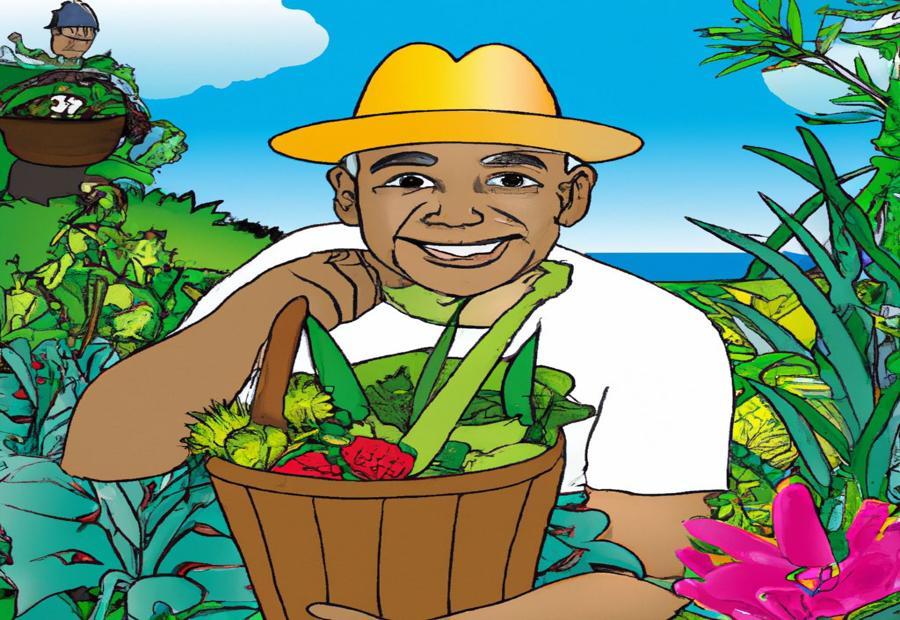
Photo Credits: Gardeninggurus.Org by Joe King
Overcoming the unique challenges of tropical gardening, let’s explore strategies for dealing with pests and diseases to ensure a thriving organic vegetable garden in tropical climates.
Dealing with Pests and Diseases
Text:
Organic vegetable gardeners in tropical climates commonly face pests and diseases. To tackle these challenges, here are some things to think about:
- Natural methods and proper care are significant for managing pests and diseases in a sustainable way.
- Ask local experts for specific advice relevant to the climate.
- Pick disease-resistant vegetables.
- Remember, prevention is often better than cure!
As an additional tip, companion planting can be an excellent way to naturally keep pests away without using any chemical pesticides.
Importance of Natural Methods and Proper Care
Organic vegetable gardening in tropical climates demands natural methods and proper care. Synthetic chemicals should not be relied upon. Instead, natural pest control and disease prevention should be prioritized for creating and sustaining a healthy and sustainable ecosystem. This includes giving plants the necessary nutrients, water, sunlight, pruning, weeding, etc.
In warm and humid climates, where pests and diseases thrive, natural methods become even more important. Beneficial insects can be attracted or trap crops used for pest control without harming the environment. Crop rotation and good sanitation practices also help reduce the risk of diseases spreading.
Organic fertilizers and compost should be used to provide adequate nutrition to the soil and promote strong plant growth. Watering must be done regularly due to high rates of evaporation.
By understanding the importance of natural methods and proper care, gardeners can achieve success in organic vegetable gardening in tropical climates.
Consultation with Local Resources for Climate-Specific Guidance
Consulting local resources for climate-specific guidance is a must for successful organic veggie gardening in tropical areas. Reach out to local experts like agricultural extension agents or experienced gardeners for advice on plant varieties, irrigation practices, pest management strategies, and soil amendments.
They can also provide solutions for unique challenges specific to certain locations within the tropics. Different areas may have variations in microclimates or local pests, so tailored approaches are needed.
To gain comprehensive understanding, consider multiple sources of info. Get insights from government agencies, research institutions, and online sources.
Local consultation is invaluable for climate-specific guidance and increasing chances of success in growing organic veggies in these environments.
Growing Vegetables in Tropical Climates
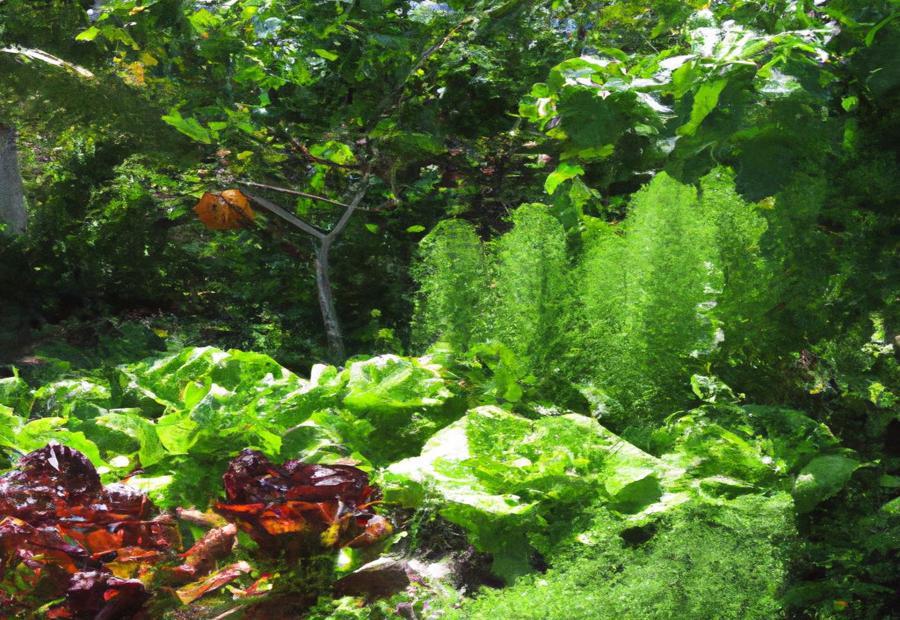
Photo Credits: Gardeninggurus.Org by Mark Baker
In the realm of growing vegetables, navigating tropical climates presents its own unique set of challenges. In this section, we’ll unfold the key aspects of growing vegetables in tropical climates, shedding light on the impact of climate on vegetable growth and providing insights into the selection of suitable vegetables for tropical gardening. Get ready to uncover valuable tips and strategies for thriving in the enticing yet sometimes demanding world of organic vegetable gardening in tropical climates.
Understanding the Impact of Climate on Vegetable Growth
Vegetable growth in tropical climates is affected by the climate conditions. Heat and humidity can have both positive and negative effects on plants. Gardeners need to research the crops that thrive in tropical conditions, like tomatoes, peppers, eggplants, okra, sweet potatoes, and various leafy greens. To ensure optimal growth, they must pay attention to soil health, watering schedules, and pest/disease prevention. This knowledge will help gardeners maximize their chances of success in organic vegetable gardening in tropical regions.
Factors Affecting Vegetable Growth in High Temperatures and Humidity
Vegetable growth in a tropical climate can be a challenge due to its hot, humid conditions. Pests and diseases, like aphids and powdery mildew, can take over. Nutrients in the soil can also be depleted faster. Excess moisture can lead to waterlogged roots and root rot.
Therefore, managing these issues is vital. Natural pest control and proper care techniques should be implemented. Amending the soil with compost or manure helps too. Good soil drainage is key.
Find the perfect vegetables for your tropical garden. With the right care, watch them thrive in the heat and humidity!
Choosing Suitable Vegetables for Tropical Gardening
When selecting vegetables for tropical gardening, key factors to consider are: temperature tolerance, humidity levels, growing seasons, disease-resistance and water usage.
Veggies adapted to high temps & humidity are likely to thrive. Shorter growing seasons can help them adapt to the limited daylight and intense heat. Disease-resistant varieties can help keep plants healthy & productive. Water-tolerant or efficient veggies help conserve water resources.
General guidelines are just the beginning. Personal preferences & local resources should be taken into account. Local experts & experienced gardeners can provide valuable insights. Also, experimenting with different varieties over time can help discover which veggies grow best in a particular microclimate.
Recommendations for Crops that Thrive in Tropical Conditions
Crops that love the tropics need special instructions for successful growth. These fruits and veggies are great for hot, humid climates. Knowing their needs is the key to a fruitful harvest.
- Choose heat-tolerant veg: Pick varieties that can handle high temperatures without wilting or suffering from heat stress. Eggplants, okra, sweet potatoes, peppers, all good.
- Select drought-resistant crops: In tropical regions with unpredictable rain, go for crops that can survive dry periods and still produce a good yield. Beans, melons, pumpkins, cucumbers – all great options.
- Consider disease-resistant varieties: Some crops are more susceptible to diseases common in tropical climates. Look for disease-resistant tomatoes, leafy greens like kale and spinach, and herbs like basil and mint.
- Embrace fast-growing vegetables: With the year-round warm climate of tropical regions, choose veg with a short growing period. Radishes, lettuce, mesclun mix, loose-leaf lettuce, bok choy, kailan, all excellent choices.
- Explore tropical fruit trees and herbs: Add beauty and fresh fruit by growing mangoes, papayas, bananas, citrus fruits, lemongrass, pandan, and more.
- Diversify with indigenous crops: Local indigenous crops are often adapted to the specific climate of the region. Try traditional crops like taro roots or cassava that have been grown in tropical climates for centuries.
When selecting crops for tropical gardening, it’s important to consider the climate, disease resistance, and temperature/humidity tolerance. This will increase the chance of success.
To optimize growth, provide enough water and irrigation systems for heavy rainfall. Also, add organic mulch to keep the soil moist and suppress weeds. Monitor and treat pests and diseases naturally. Observe local resources and talk to experts about tropical gardening. Implement these tips and create an environment ideal for growing tropical crops.
Tomatoes and lettuce’s FB status? ‘It’s complicated’!
Considerations for Tomatoes and Lettuce Varieties
Gardening in tropical climates requires extra care for tomatoes and lettuce. Here’s what to consider for success.
Tomatoes:
- Love warm temps between 75°F & 85°F (24°C to 29°C).
- Need full sun.
- Keep soil moist, but not too much.
- Well-draining soil with organic matter & 6-7 pH.
- Mulch with straw or grass clippings.
- Watch for pests & diseases like blight or wilt.
- Choose heat-tolerant varieties.
Lettuce:
- Prefer cooler temps from 60°F to 70°F (15°C to 21°C).
- Can handle some shade during hot periods.
- Water regularly to maintain soil moisture.
- Loose, rich soil with organic matter & pH 6-7.5.
- Apply mulch like straw or compost.
- Watch out for slugs, snails, aphids, & leafminers.
- Choose heat-resistant cultivars.
Consistent care & attention is key. Monitor for pests & diseases, use organic pest control, water & feed properly, and keep environmental conditions right. Follow these tips and you’ll maximize your yield while growing healthy tomatoes & lettuce!
Successful Techniques for Tropical Gardening
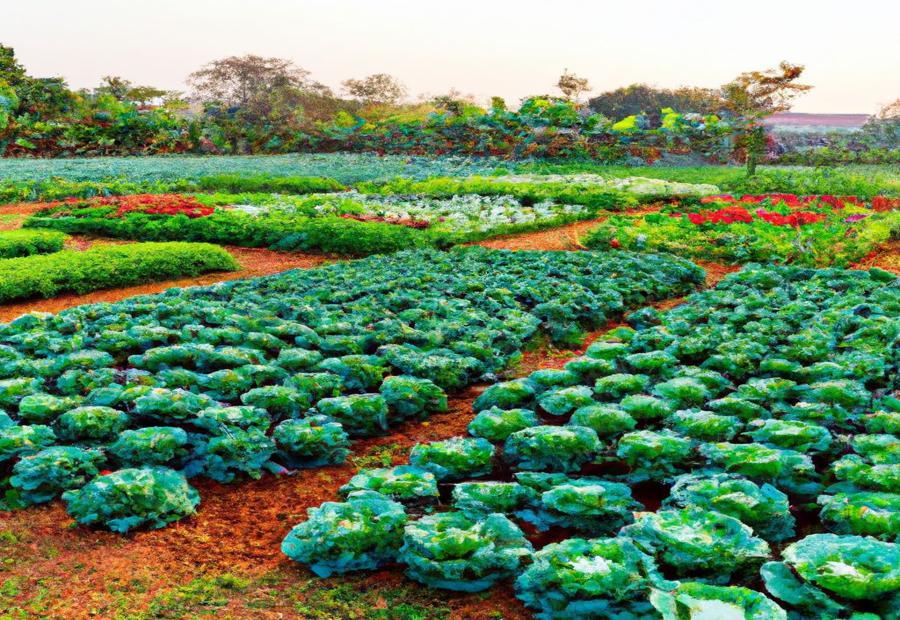
Photo Credits: Gardeninggurus.Org by Jack Mitchell
Discover valuable techniques for successful tropical gardening, including maintaining soil and plant health, as well as adapting to the challenges posed by both rainy and dry seasons. Uncover expert tips and strategies to maximize the productivity of your organic vegetable garden in tropical climates.
Maintaining Soil and Plant Health
Organic matter must be added to the soil regularly, to retain its fertility and structure. Compost, aged manure, and other organic materials can be used to enhance its nutrient content and water-holding capacity.
Crop rotation can help stop build-up of pests and diseases. By changing crops every season, veggie gardeners can reduce the risk of plant pathogens and pests.
Natural pest control methods, like companion planting or introducing beneficial insects, can help keep a balanced garden ecosystem. This cuts down on chemical pesticides and promotes a sustainable gardening approach.
Regularly monitoring plants for signs of nutrient deficiencies or pest infestations is important. Adjusting fertilization or addressing pest issues straight away prevents further harm to plants and keeps them healthy.
Plus, different veggies may have special needs for soil pH, drainage, and sunlight. Paying attention to these individual needs when maintaining soil and plant health boosts a thriving veggie garden in tropical climates.
By following these guidelines for maintaining soil and plant health, organic vegetable gardeners in tropical climates can create an environment that boosts growth and minimizes the need for synthetic inputs like chemical fertilizers or pesticides. Taking a proactive approach to caring for healthy soil ensures that plants have access to the nutrients they need, as well as promoting sustainable gardening practices.
Recommendations for Soil Amendments and Traditional Vegetables
Soil amendment is vital for success in organic veg gardening, especially in tropical climates. The soil quality affects plant growth and health. Therefore, it’s key to make the right amendments and choose traditional veggies that thrive there.
Compost is a great source of organic matter and nutrients for the soil. It boosts soil structure, drainage, and microbial action. Bone meal, blood meal, and fish emulsion are organic fertilizers that provide essential macro- and micronutrients. Mulch, such as straw or wood chips, helps retain moisture and regulate soil temperature. Rotating crops prevents nutrient depletion and pest infestations. Testing the soil checks pH so you can adjust with lime or sulfur if needed.
Traditional vegetables for tropical climates include tomatoes, cucumbers, peppers, beans, okra, sweet potatoes, eggplants, and leafy greens like spinach and kale.
To find success:
- Offer sunlight and water to the veggies.
- Monitor and supplement soil nutrients.
- Crop rotate to avoid pests and diseases.
- Use natural pest control methods.
With these amendments and suitable veggies, gardeners can create fruitful organic veg gardens in tropical climates. Knowing when to dance in the rain and pray for a drop of water is the key to success!
Adapting to Rainy and Dry Seasons
Rainy and dry seasons present unique difficulties for gardening in tropical climates. Gardeners must modify their methods to suit the varying weather conditions to be successful in growth and productivity.
To safeguard crops during rainy seasons:
- Excess moisture may cause waterlogging and plant diseases. To avoid water stagnation and support root health, gardeners can install raised beds or proper drainage systems.
- Covers like plastic sheets or mulch can also protect crops from heavy rainfall.
Conserving water during dry seasons:
- Dry season presents water scarcity. Gardeners can save water and hydrate plants with efficient techniques like drip irrigation or rainwater harvesting.
- Proper mulching will also help keep the soil moist.
Choosing drought-tolerant varieties:
- To adapt to both seasons, select plants that thrive in humid climates. Drought-tolerant varieties can tolerate periods of water shortage and high humidity.
Crop rotation:
- Crop rotation is helpful for adapting to seasonal changes. It maintains soil health, prevents nutrient depletion, and reduces pests. It allows for better plant management throughout the year.
Monitor the weather:
- Gardeners must check reliable weather sources to plan their planting schedules. Adapting gardening practices to both seasons boosts chances of success.
Local climate:
- Rainfall patterns differ from area to area, so it is important to understand the local climate. Agricultural extension offices and experienced gardeners can offer guidance on adapting to rainy and dry seasons.
Indigenous practices:
- Indigenous communities in tropical regions have developed innovative techniques to adapt to the climate. Rainwater harvesting systems, terracing methods, and crop diversification are useful lessons for modern gardeners.
Making the right choices:
In tropical gardening, success depends on making the right choices at the right time. Careful selection and timing of crops can overcome the challenges of adapting to seasons.
Best Practices for Selecting Crops and Planting Timing
In tropical climates, selecting the right crops and timing for planting are key to successful organic veggie gardening. Knowing the special features of these climates is critical for making informed decisions. Here are best practices for selecting crops and deciding the right timing for planting:
- Look at heat and humidity tolerance. Pick varieties that can manage high temps & humidity. E.g. peppers, okra & sweet potatoes. Leafy greens are also heat-friendly.
- Evaluate water needs. Notice water needs for each crop. Some crops, like tomatoes & cucumbers, require more water than others. Consider irrigation systems or natural rainfall patterns.
- Plan around rainy & dry seasons. When determining the best time to plant, look at seasonal rainfall patterns in your region. E.g. if you experience heavy rains, plant crops that love wet conditions.
- Think about crop maturation times. Factor in the number of days it takes each crop to mature when planning your planting schedule. This way you can have a continuous supply of fresh produce.
- Consult local resources. Get guidance from agricultural extension offices or experienced gardeners in your area. They can provide location-specific insights.
By following these best practices, organic veggie gardeners in tropical climates can improve their chances of success. Growing your own veggies in the tropics is easy – just add water and watch them thrive!
Exploring Easy-to-Grow Vegetables in the Tropics

Photo Credits: Gardeninggurus.Org by Wayne Adams
Discover a world of easy-to-grow vegetables specifically curated for tropical gardens. From a wide variety of crops to helpful growing tips, this section will equip you with the knowledge to create a thriving organic vegetable garden in tropical climates. So, whether you’re a beginner or have a green thumb, get ready to explore the best vegetables suited for your tropical garden and gain valuable insights on how to cultivate them successfully.
A Variety of Crops for Tropical Gardens
Tropical gardens offer a wide range of crops that can thrive in the specific climate conditions. Heat and humidity are ideal for these plants. Therefore, gardeners can enjoy fruits and vegetables all year round.
Let’s look at some popular choices:
| Crop | Description |
|---|---|
| Tomatoes | Cherry tomatoes, heat-tolerant varieties |
| Cucumbers | Needs warm temperatures & ample sunlight |
| Peppers | Bell peppers, chili peppers, & other hot varieties |
| Eggplants | Hardy varieties that can handle high humidity |
| Yams | Root veggies that love tropical climates |
| Pineapples | Spiky leaves, sweet flesh – tropical fruit! |
By selecting different crops, gardeners can have a diverse harvest. There are also lots of other options, like beans, peas, okra, corn, spinach, kale, cilantro, basil, bananas, papayas, and mangoes.
Tropical gardens can be vibrant and productive, filled with homegrown produce. Tomatoes, pineapples, and more – the possibilities are endless!
List of Easy-to-Grow Vegetables and Medicinal Plants
Organic vegetable gardening in tropical climates needs careful consideration of aspects like high temperatures, humidity, and finding the perfect crops. But, novice gardeners will find success!
Leafy greens like lettuce, spinach, and kale are easy to grow and provide essential nutrients. Herbs like basil, mint, and cilantro require little maintenance and can be used in many dishes. Tomatoes demand extra attention but, when watered and given the right amount of sunlight, they produce plenty of crops. Medicinal plants such as aloe vera, turmeric, and lemongrass are not only easy-to-grow, but beneficial for health, too. Plus, there are many more vegetables and medicinals suitable for tropical climates! Gardeners have to know the particular demands of each plant before including them in their garden.
Growing Tips for Specific Vegetables
Growing specific vegetables requires specific techniques. Watering and sunlight are must-haves for beans, peas, eggplants, and turmeric. Pruning and trellising can further boost growth for climbing veggies like beans and peas. Harvesting at the right time will provide the best flavor and texture. Moreover, soil health, nutrient requirements, and pest management should be monitored. Organic fertilizers and natural control methods help with overall health and productivity.
In tropical climates, such as Southeast Asia, gardening challenges are prevalent. Soil amendments, seed trays, and vegetable bed recommendations must be considered. Following these tips will increase the chances of success in cultivating thriving gardens.
Guidelines for Beans, Peas, Turmeric, Eggplants, and More
Tropical veg such as beans, peas, turmeric and eggplants need special guidelines for successful growth. These include instructions on planting techniques, ideal conditions and pest management strategies. Here’s a table to give an overview:
| Veg | Planting Season | Optimal Growing Conditions | Pest Management |
|---|---|---|---|
| Beans | Year-round | Full sun; well-drained soil | Aphids; organic insecticides |
| Peas | Cool season | Partial shade; rich soil | Powdery mildew; caterpillars; treatment |
| Turmeric | Year-round | Partial shade; loamy soil | Weed control; fungicides |
| Eggplants | Warm season | Full sun; nutrient-rich soil | Fruit fly netting/traps |
| Other Veg | Varies | Varies | Varies |
Regular watering is also key for successful veg cultivation. Monitor soil moisture to prevent underwatering/overwatering. These guidelines will help gardeners get a great veg harvest!
Tropical Vegetables for a Successful Garden

Photo Credits: Gardeninggurus.Org by Kevin King
In order to create a successful organic vegetable garden in tropical climates, it is important to choose the right tropical vegetables. In this section, we will explore two key aspects: heat and humidity tolerant vegetables, as well as substitutions and alternatives for lettuce. By understanding the unique properties of these vegetables, gardeners can ensure a thriving garden despite the challenges posed by tropical climates.
Heat and Humidity Tolerant Vegetables
In tropical climates with high temps and humidity, heat- and humidity-tolerant veggies are essential for a successful harvest. These veggies have unique characteristics that help them survive the extreme conditions.
Some of the heat- and humidity-tolerant vegetables include:
– Leafy greens like kale, spinach, and Swiss chard are great choices. They have thick leaves that keep them moist and can withstand a lot of heat.
– Okra is another veggie that prospers in hot, humid climates. It produces tender pods, perfect for cooking.
– Sweet potatoes also tolerate high temps and humidity well. They have deep roots for accessing water during dry spells, plus they provide a good source of carbs.
– Malabar spinach loves warm and moist environments. It has thick, succulent leaves with a mild flavor – perfect for salads and stir-fries. Plus, it’s rich in vitamins A and C.
– Bitter gourd, yard-long beans, and bottle gourd are other varieties that can thrive in tropical climates. They have mechanisms for coping with the heat and moisture.
To ensure these veggies survive, gardeners should take specific measures. Provide shade or use mulch to protect plants from direct sunlight during the hottest hours. Water regularly, but not too much – too much moisture can lead to fungal diseases. Use organic fertilizer for healthy growth. Last, monitor for pests like aphids and whiteflies, which can attack weakened plants more easily.
By following these practices, gardeners can have a bountiful harvest of heat and humidity-tolerant vegetables in tropical climates. As tough as ghosts in a haunted house!
Recommended Varieties Suitable for Hot Climates
Hot climates present peculiar challenges for veggie gardening. To succeed, select varieties that can flourish in the heat. Here are some to consider:
- Heat-tolerant tomatoes. Varieties with thicker skin can handle high temperatures without sacrificing quality.
- Chili peppers like jalapenos, habaneros, and Thai chilies are perfect for hot climates. Spice up your dishes with these!
- Okra loves the sun and warmth. Look for dark green pod varieties like Clemson Spineless or Emerald.
- Sweet potatoes are ideal for warm climates. Varieties like Beauregard or Centennial are heat-tolerant.
- Asian greens like bok choy, Chinese cabbage, and mustard greens have been farmed in hot weather for centuries.
Selecting these plants can guarantee a successful and rewarding garden experience. Try these tropical alternatives and be pleasantly surprised!
Substitutions and Alternatives for Lettuce
Lettuce may not be ideal for growing in tropical climates because of the heat and humidity. But, there are several substitutions and alternatives that you can use.
- Amaranth, kangkong (water spinach), and malabar spinach, are all leafy greens that can tolerate warm climates.
- Herbs like basil, cilantro, and mint can be used as salad greens instead.
- Chayote squash and bitter melon make wonderful lettuce substitutes in salads or stir-fry dishes.
- Microgreens, such as radish, broccoli, and arugula, are also a great option.
When selecting substitutes, take into account the soil type, sunlight exposure, and watering needs of your garden. This will help ensure success in tropical climates.
Tropical Lettuce Substitutes and Other Suitable Greens
Tropical climates can be tricky when it comes to growing lettuce and other greens. But, don’t worry! There are alternatives that can survive in these conditions. These tropical lettuce substitutes and other suitable greens offer similar flavors and textures to traditional lettuce varieties. Let’s explore them!
Amaranth, Kangkong (Water Spinach), Roselle (Hibiscus), and Swiss Chard are some of the greens that thrive in tropical climates. Plus, they provide plenty of nutritional benefits. Amaranth, for instance, is full of vitamins and minerals. Malabar Spinach is also a great option with succulent leaves and a mild flavor.
It’s important to note that since these substitutes are tailored for tropical climates, they may require different growing conditions or care compared to traditional lettuce varieties.
It’s awesome to know that we can have diverse greens in tropical gardens by taking advantage of these lettuce substitutes!
A Guide to Gardening in Southeast Asia
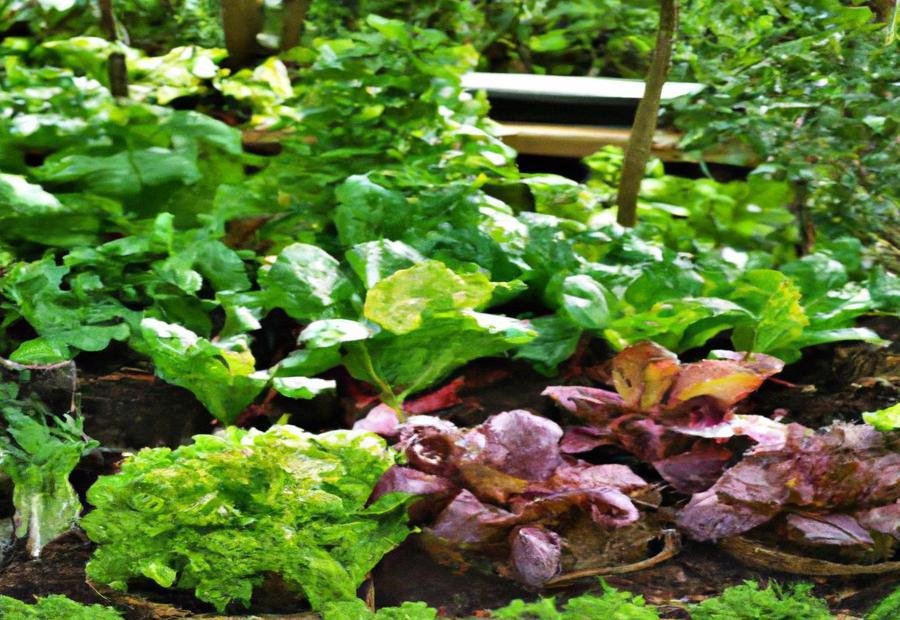
Photo Credits: Gardeninggurus.Org by Christopher Nguyen
Navigating the unique climate of Southeast Asia can present challenges when it comes to organic vegetable gardening. In this guide, we will explore key aspects that can help you succeed in your gardening endeavors. From understanding the weather patterns and seasons specific to Southeast Asia to tackling garden challenges and implementing soil improvement and planting techniques, this comprehensive guide will equip you with the knowledge and strategies needed to cultivate a thriving organic vegetable garden in tropical climates.
Weather and Seasons in Southeast Asia
Southeast Asia has two seasons – wet and dry. The wet season, also called the rainy season, brings heavy rainfall and high humidity. This can cause soil erosion, weed growth and diseases. The dry season has less rain, so gardeners must be careful with irrigation. Plus, higher temperatures and evaporation can affect plants.
Still, the weather patterns can vary by country. Thailand and Malaysia have monsoon rains during certain months (BBC Weather). It’s important to recognize these differences.
Understanding Two Main Seasons and Their Impact
Tropical climates require an understanding of the two main seasons and their effects on vegetable growth, especially in gardening. Let’s look at the Rainy Season. It brings a lot of rain, high humidity, and warm temperatures. Though it provides water for plants, it can also cause too much moisture, leading to disease and root rot. To counter this, selecting crops that can cope with the moisture and proper drainage is important.
The Dry Season is different. Rainfall decreases and it’s drier. This means gardeners must adopt strategies to conserve water and irrigate their plants. It’s important to pick drought-tolerant crops and use efficient watering techniques.
Knowing the characteristics of these two seasons helps gardeners make decisions about crop selection, irrigation methods, and disease prevention. Adapting planting schedules, using proper soil amendments, and using appropriate watering techniques are all key factors in successful vegetable gardening.
Local resources and help from experts who understand the climate should be used, rather than resorting to chemicals and pesticides. Natural methods and best practices tailored to the seasonal variations will help with organic vegetable gardening success.
In summary, managing garden challenges in tropical climates requires knowledge and bug spray. By understanding the two main seasons and their impact, gardeners can plan and adapt their gardening techniques, ensuring vegetable growth in these regions.
Managing Garden Challenges
Tropical climates bring with them unpredictable weather, pests and diseases, soil moisture levels, extreme heat and humidity, and weed growth. To tackle these challenges, one must use natural pest control methods, irrigate properly, provide shade and shelter during hot and humid times, remove weeds regularly, and make sure there is proper drainage when it rains.
By taking these steps, gardeners can overcome the unique dilemmas of gardening in a tropical climate. It will ensure healthy plants and a successful harvest!
Gardening in the tropics is like battling a war – you need resilience, a bit of luck, and a lot of bug spray!
Advice for Hot and Rainy Seasons, Pests, and Diseases
Gardening in tropical climates can be tricky during hot, rainy seasons. Pests and diseases flourish in these conditions. But, there are strategies to reduce the risk of infestations and infections. Natural pest control methods, like companion planting and biological controls, can create a balanced garden ecosystem. Predators and organic insecticides can also help.
Disease prevention is essential. Regularly removing diseased plants and leaves helps keep infections at bay. Watering plants at the base, not overhead, reduces humidity and disease growth. Additionally, proper spacing between plants encourages air circulation and reduces humidity.
Monitoring soil moisture levels is key. Tropical climates can receive lots of rain, but mulching helps to retain water and regulate temperature. Following these tips ensures optimal growing conditions for organic vegetables. Digging in the tropics can be difficult, but soil improvement and planting techniques make it easier.
Soil Improvement and Planting Techniques
Choosing the right soil amendments is a must for better soil quality and fertility. Compost or well-made compost is great for adding essential nutrients to the soil. Mixing compost with existing soil helps create a nutrient-rich environment that promotes root growth and plant development.
Recommended planting techniques include using designated holes or lines for seeds and seedlings, which results in efficient use of space and resources. Regular monitoring and maintenance of the soil is necessary for a healthy garden in tropical climates.
Crop rotation, natural pest control methods, and providing adequate water and nutrients are all essential components for maintaining a healthy garden ecosystem. Adding organic matter to the soil can increase its water-holding capacity, resulting in better moisture retention during dry periods.
Soil Amendments, Seed Trays, and Vegetable Bed Recommendations
Soil amendments are super important for successful organic vegetable gardening in tropical climates! They increase nutrient content and structure of the soil. Adding organic matter like compost, manure, or leaf mold can help with water retention, drainage, and nutrients. Seed trays are also great for the germination process and growing young seedlings in a controlled environment. Lastly, raised beds with good drainage prevent waterlogging and adding mulch keeps the soil temperature regulated.
Remember, different veggies have different requirements for soil and bed prep. Conduct research to make sure you’re making the right adjustments. For even more success, consult local experts or resources for climate-specific guidance. Pests and diseases specific to the tropics can be avoided with their help!
Fun Fact: Using proper soil amendments can lead to healthier vegetable plants!
Thriving Vegetable and Fruit Trees in the Tropics
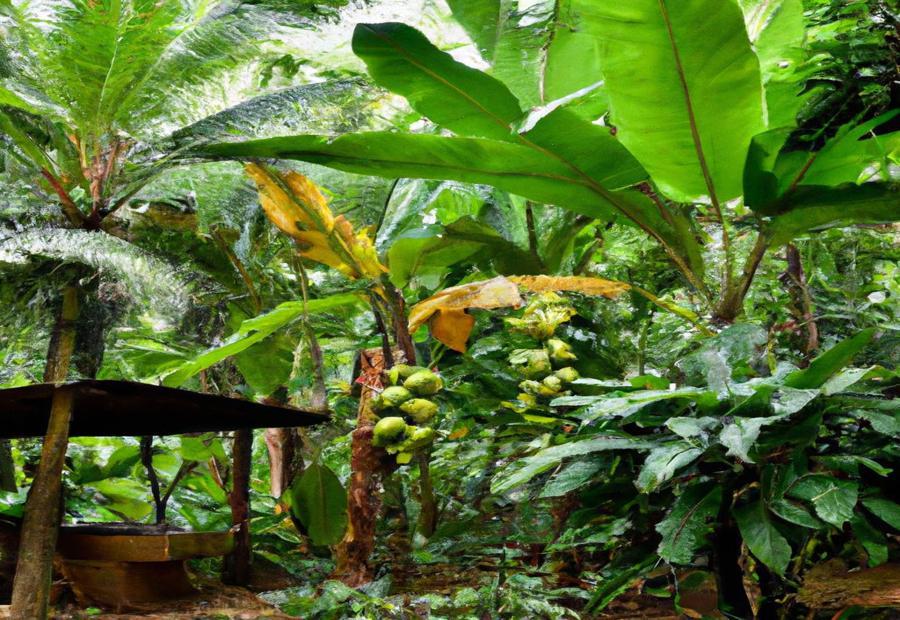
Photo Credits: Gardeninggurus.Org by Gregory Adams
Discover the secrets to cultivating thriving vegetable and fruit trees in tropical climates as we explore two key aspects. In 14.1, we’ll unveil year-round vegetable varieties that thrive in tropical climates, ensuring a bountiful harvest throughout the seasons. Then, in 14.2, we’ll uncover the most popular fruit trees that flourish in tropical gardens, offering a delightful addition to your homegrown produce. Let’s unlock the potential of organic gardening in tropical paradises.
Year-Round Vegetables in Tropical Climates
Tropical climates provide ideal conditions for growing vegetables all year round. Warm, consistent temperatures, sunshine and high humidity create a perfect atmosphere. With a bit of planning and choosing suitable varieties, gardeners can enjoy a continuous harvest.
Let’s explore a few popular vegetable options:
| Vegetable | Cultivation Season | Growing Tips |
|---|---|---|
| Tomatoes | Year-round | Give vines support and protect from rain. |
| Eggplants | Year-round | Choose heat-tolerant types and watch out for pests. |
| Lettuce | Cooler months or partially-shaded areas in hot seasons | Pick heat-resistant varieties like leafy greens or head lettuce. |
Apart from these regular veggies, there are unique ones that also thrive in tropical climates. These include leafy greens like spinach, kale and Asian greens, and herbs such as basil, coriander and mint. By diversifying vegetable selections and using both open-field and container gardening, gardeners can have plenty of fresh produce throughout the year.
Succession planting is the key to successful year-round veg garden in tropical climates. Sow seeds or transplant seedlings in regular intervals for a steady supply of mature plants ready for harvest. This helps you avoid gluts or shortages of any particular veggie.
It’s important to note that suitable vegetables for year-round cultivation vary depending on local climate and microclimates in the region. It’s wise to consult experienced gardeners familiar with the area for the best veg choices for sustained cultivation.
Highlighting Vegetables Suitable for Year-Round Cultivation
Year-round veggie cultivation in tropical climates is a must for successful organic gardening. The consistent weather allows for continuous growth and harvest, providing a steady supply of fresh produce. To get the best results, choose veg that thrive in these conditions.
Leafy greens such as spinach, kale and Swiss chard are great for year-round cultivation. They are heat and humidity tolerant and can be harvested continuously. Many herbs like basil, mint, coriander and lemongrass will also do well.
Root veggies like carrots and radishes have shorter growing seasons and can be harvested quickly. Fruit trees like papaya, banana, mango and avocado bear fruit all year round and look great in the garden.
Soil quality, watering requirements and pest control are other factors to consider. If you pick the right crops and use the right techniques, you’ll get an abundant garden with fresh produce all year round. Remember that some veg may require specific planting schedules or extra care during certain seasons. Consider the local climate and the individual requirements of each veg to ensure a successful harvest.
Popular Fruit Trees for Tropical Gardens
Tropical gardens are made even more beautiful and delicious with the addition of popular fruit trees. These trees require full sun and well-drained soil to thrive.
Mangoes are a favorite among gardeners. They come in all sizes and flavors.
Papaya trees provide large, vitamin-rich fruits. They adapt to different soil types and prefer sunny locations.
Banana trees are a staple in tropical gardens. They require full sun and moist soil. Varieties of bananas have their own unique flavors.
Other options for tropical gardens include guava, pineapple, coconut, and passion fruit. Each of these trees has its own needs regarding sunlight, soil, and water.
Tropical gardens become a paradise with these fruit trees and herbs. With proper care, they are a rewarding addition!
Recommendations for Various Tropical Fruit Trees and Herbs
For successful gardening in tropical climates, it’s essential to have recommendations for various tropical fruit trees and herbs. The right fruits and herbs can greatly affect the health and productivity of a garden.
To help with this, there’s a table with recommended varieties:
| Fruit Trees | Recommended Varieties |
|---|---|
| Mango | Alphonso, Kent |
| Papaya | Red Lady, Solo |
| Banana | Cavendish, Lady Finger |
| Guava | Thai White, Apple |
| Pineapple | Cayenne, Queen |
Herbs for tropical gardens are also suggested. These include lemongrass, basil, mint, turmeric, and ginger. Not only do these herbs spice up dishes, but they offer medicinal benefits too!
By selecting and caring for the recommended fruit trees and herbs, gardeners in tropical climates can enjoy the flavours and advantages they have to offer. Knowing the needs of each variety helps to ensure successful growth and a plentiful harvest.
Gardening Tips for Success

Photo Credits: Gardeninggurus.Org by Ronald Williams
For a thriving organic vegetable garden in tropical climates, it’s vital to follow essential gardening tips to ensure success. This section explores two key aspects: protection and precautions in the tropics and the effort and enjoyment involved in tropical gardening. Discover valuable insights and practical advice that will help you create a bountiful and fulfilling gardening experience in the challenging tropical environment.
Protection and Precautions in the Tropics
Protection and precautions are key when gardening in tropical climates. High temps and humidity can lead to pests and diseases. Gardeners must take steps to protect plants. Natural pest control and proper care is essential.
- Wear protection like long sleeves, pants, gloves, and hats. This safeguards from sunburns and insect bites.
- Monitor plants for signs of distress or disease. Early detection prevents spread and maintains health. If unsure, consult local resources like horticulture extension services.
- Protecting plants from pests, diseases, and environmental factors is essential in tropical climates. Follow natural pest control, proper care, protective clothing, and seek advice. This allows for successful organic vegetable gardening while minimizing risks.
Dealing with Pests and Wearing Protective Clothing
Organic veggie gardening in tropical climates? Protect both your plants and yourself from pests and diseases! Wear protective clothing and take precautions. Here’s a four-step guide to success:
- Identify Common Garden Pests: Know what you’re up against. Learn about common pests in tropical climates like aphids, whiteflies, caterpillars, and snails.
- Implement Natural Pest Control Methods: Use natural methods of control to avoid harmful chemicals. Try companion planting and invite beneficial insects like ladybugs and lacewings.
- Wear Protective Clothing: Shield yourself from allergens and insect bites. Wear gloves, long-sleeved shirts, and pants.
- Regular Inspections and Monitoring: Take regular inspections. Be vigilant. Then you can take action if an issue arises.
Unique details and organic pest control are important too. Remember prevention is key to successful organic gardening. Start your organic veggie garden today! Enjoy the satisfaction of sustainable practices.
Effort and Enjoyment of Tropical Gardening
Tropical gardening takes effort and commitment, but can be immensely gratifying. Warmth and lots of rain make plants grow with vigor. But high heat and humidity can be arduous for both gardeners and their crops. With proper care, however, tropical gardening can be rewarding.
Comprehending the influence of climate on vegetable growth is key. Consider temperature and humidity when choosing veggies, like tomatoes, peppers, eggplants, beans, okra, sweet potatoes, and leafy greens. This increases the chance of success.
Soil and plant health are essential. Compost and organic matter can enrich fertility. Turmeric can also help soil. Adapt to the wet and dry seasons by selecting plants that can withstand heavy rain or drought.
Pests and diseases may be a problem. Organic gardeners should use natural methods like companion planting and biological pest control. Monitor plants for signs of pests or sickness so that appropriate actions can be taken quickly.
Pro Tip: Protect yourself from pests like mosquitoes. Wear protective clothing and take regular breaks in the shade to stay hydrated and safe from heat-related illnesses.
Acknowledging the Challenges and Rewards of Gardening in the Tropics
Gardening in the tropics can be quite the endeavor! High temperatures and humidity bring their own set of obstacles. But with the right care and natural methods, those challenges can be conquered. Local resources are the best for gaining advice tailored to the climate.
Despite the difficulties, tropical gardening offers many rewards. One of the biggest is the opportunity to cultivate a large variety of veggies that thrive in tropical climates. By following recommendations for crops and tips for specific veggies, you’ll be on the road to success.
This guide acknowledges the challenges and joys of tropical gardening. So, don some sunscreen and start exploring the world of tropical gardening!
Conclusion
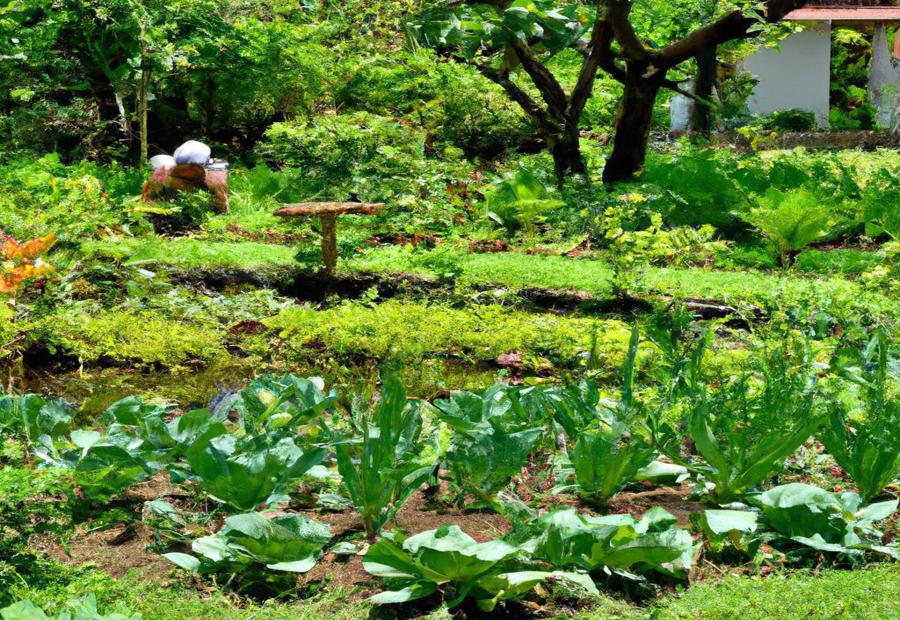
Photo Credits: Gardeninggurus.Org by Jordan Sanchez
In the conclusion section, we will recap the key points discussed in the article on organic vegetable gardening in tropical climates and provide encouragement for successful organic gardening in such environments. With these valuable insights, you can embark on your organic gardening journey with confidence and maximize your harvest in tropical climates.
Recap of Key Points
Recapping the key points of organic vegetable gardening in tropical climates is crucial! These points include:
- Differences between tropical and subtropical climates
- Making well-made compost and its importance for seeds/seedlings
- Starting with a weed-free site and the benefits of a gently sloping one with good drainage
Furthermore, it’s essential to consider unique factors like overcoming challenges with natural methods, selecting veggies that fit the climate, and amending soil/plant health. Plus, consulting local resources for climate-specific guidance is a must for pest/disease management.
Encouragement for Successful Organic Vegetable Gardening in Tropical Climates.
Encouraging successful organic veggie gardening in tropical climates is critical for sustainable and healthy food production. It’s vital to know the unique characteristics and challenges of these regions. By doing so, gardeners can optimize their techniques and gain bountiful results.
To help out gardeners in tropical climates, here’s a 5-step plan to foster success:
- Composting: High-quality compost is necessary for seed or seedling growth. Create well-made compost using organic materials for plants to get vital nutrients.
- Garden site: Clear the site of weeds and grass for a weed-free environment. Opt for gently sloping sites with good drainage to avoid waterlogging.
- No-dig gardening method: Use extra newspaper layers as a barrier against weeds. Suitable mulching options like blady grass hay should be used. Exercise caution with straw, as it may lead to germination.
- Plant and grow: Water properly and make organic matter decompose in soil. Mix compost with soil in holes or lines for plant roots to get essential nutrients. Start small and gradually expand for easier management and higher chances of success.
- Recommended veggies: Plant vegetables that thrive in subtropical and tropical climates. Consider the impact of climate on veggie growth in high temperatures and humidity. Choose veggies that do well in tropical conditions.
Lastly, consult local resources for climate-specific guidance and advice on natural pest control methods and proper care. This will help gardeners win the challenges of tropical gardening!
Pro Tip: Get guidance and advice from local sources for successful organic veggie gardening in tropical climates.
Some Facts About Organic Vegetable Gardening In Tropical Climates:
- ✅ It is recommended to have well-made compost for seeds or seedlings in organic vegetable gardening in tropical climates. (Source: Team Research)
- ✅ Blady grass hay is a good mulch option for organic vegetable gardening in tropical climates, as it breaks down quickly. (Source: Team Research)
- ✅ Vegetables like beans, cucumbers, eggplant, peppers, pumpkin, squash, sweet corn, tomatoes, and watermelon are popular choices for organic vegetable gardening in subtropical and tropical climates. (Source: blog.planter.garden)
- ✅ Cool-weather crops like broccoli, cauliflower, and cabbage are not suitable for tropical climates but can be grown in subtropical regions during the cool season. (Source: blog.planter.garden)
- ✅ Organic vegetable gardening in tropical climates can expand cooking options to include exotic tropical cuisines. (Source: down2earthph.com)
FAQs about Organic Vegetable Gardening In Tropical Climates
Can cool weather crops be grown in tropical climates?
No, cool weather crops like broccoli, cauliflower, and cabbage are not suitable for tropical climates. They are more suited to temperate zones and cooler weather.
How can plastic row covers be used in tropical gardening?
Plastic row covers can be used in tropical gardening to protect plants from excessive rain and pests. They create a barrier that helps regulate temperature and humidity while allowing sunlight to reach the plants.
What are some popular leafy vegetables to grow in tropical climates?
In tropical climates, popular leafy vegetables include wong bok, tatsoi, mustard leaves, and oak leaf lettuce. These varieties are more heat-tolerant and can thrive in warm weather conditions.
What is the advantage of using raised vegetable beds in tropical gardening?
Raised vegetable beds are recommended in tropical gardening to prevent pooling of water during seasonal rains. This helps in maintaining proper drainage and preventing waterlogged soil, which can be detrimental to plant health.
How can organic mulch hay be used in sustainable vegetable gardening in tropical climates?
Organic mulch hay, such as blady grass hay, can be used as a protective layer around plants in tropical gardening. It helps conserve moisture, suppress weed growth, and gradually breaks down, providing nutrients to the soil.
Which vegetables are considered heat-tolerant varieties for tropical climates?
Heat-tolerant varieties suitable for tropical climates include sweet corn, Asian cucumber, and continental cucumbers. These varieties have adaptations that allow them to thrive in high temperatures and humidity.


